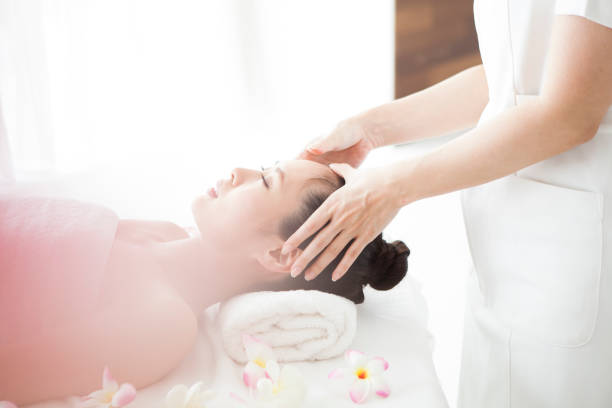Your Scalp Needs This: The Right Japanese Head Spa Routine

Did you know a typical scalp produces about 500,000 strands of hair every day? That’s a lot of activity happening up there. With all that work, it’s no surprise our heads need some attention too. That’s where a Japanese Head Spa comes in. This deep scalp therapy is gaining popularity for all the right reasons.
But here’s the big question: how often should you actually go?
Let’s break it down.
Understanding What Happens During a Japanese Head Spa
First, let’s talk about what really happens during this treatment. It’s not just a fancy shampoo.
During the session, a skilled therapist focuses on your scalp using warm steam, essential oils, and soothing massage techniques. This helps increase blood flow, unclog pores, and ease tension in your neck and shoulders.
And yes, it’s relaxing. But it’s also backed by science. Improved scalp circulation promotes hair growth and healthier roots. That’s why many choose it not just for stress relief, but for long-term hair care.
So before planning how often to go, it’s important to understand what each session does.
Signs You Might Need It More Often
However, not everyone needs the same schedule. Certain signs may indicate you should consider booking more frequently.
Here’s what to watch for:
- Your scalp feels oily or itchy, even after washing.
- You notice more hair shedding than usual.
- Styling products build up quickly on your scalp.
- You’re under constant stress or lack sleep.
- You wear tight hairstyles or hats daily.
If two or more of these apply, then more frequent visits could be beneficial. Keep in mind that your scalp health can fluctuate based on your lifestyle; therefore, it’s wise to assess it regularly.
How Your Hair Type Plays a Role
Various hair types, consequently, signify varying needs. Curly, straight, thick, or fine, each type reacts differently to scalp buildup; therefore, care must be tailored accordingly.
For example, people with thick or curly hair often produce more oil. These can trap dirt close to the scalp. On the flip side, fine hair might show damage faster, especially when paired with frequent heat styling.
Because a Japanese Head Spa targets the scalp and not just the hair, it works well for all types. Still, how often you go may change depending on how your hair responds over time.
Suggested Booking Frequency Based on Your Lifestyle
Now that we’ve looked at symptoms and hair types, let’s talk lifestyle. Here’s a quick breakdown based on your daily habits:
- Busy urban environment: Once every 2–3 weeks (pollution affects scalp health).
- Active gym-goer: Weekly or bi-weekly (sweat buildup needs clearing).
- Minimal product use, low-stress lifestyle: Once a month is often enough.
- Postpartum or recovering from illness: Weekly treatments may aid recovery.
- Frequent use of dry shampoo or styling tools: Every 2–3 weeks helps remove buildup.
Think of it like your dental cleanings. You don’t wait for cavities—you go for maintenance. The same mindset works here.
The Benefits of Sticking to a Routine
Staying consistent with head spa sessions has noticeable results. When you commit to a regular routine, you’ll start seeing:
- Reduced scalp dryness and flakiness
- Stronger, shinier hair strands
- Less daily shedding
- Faster hair growth
- Fewer headaches and less tension
Plus, Japanese Head Spa can relief you get from a deep scalp massage can improve sleep and boost mood. It’s not just hair care—it’s full-body balance.
That’s why many choose to set their appointments in advance rather than waiting for issues to show up.
Why Seasonal Changes Matter Too
Did you know your scalp changes with the seasons? Yep, weather plays a huge part in how your skin behaves—especially on your head.
In winter, dry air and indoor heat lead to flakiness. Summer? Heat and sweat cause buildup and clogged pores. That’s why adjusting your booking frequency with the seasons makes sense.
During colder months, consider going every 2–3 weeks to keep the dryness under control. In warmer months, sweat and sunscreen buildup might need bi-weekly care.
Monitoring how your scalp reacts to seasonal shifts will help you stay ahead of problems.
What to Expect Between Appointments
So what happens between your appointments? Are there things you should or shouldn’t do?
Absolutely. Between visits, keeping up with basic scalp care makes a big difference. Use a mild, sulfate-free shampoo. Avoid heavy styling products if possible. And make sure you’re drinking plenty of water.
Remember to brush your hair gently to distribute natural oils. This supports scalp health and reduces the need for more intense cleanings.
Even with the best care, though, you’ll still benefit from that professional touch a Japanese Head Spa provides.
Final Thoughts: Making It Work for You
Everyone’s scalp is different, and no single answer works for all. That’s why starting with a Japanese Head Spa session and tracking how you feel after is key. If you notice less tension, reduced flakes, and better hair texture, that’s a sign you’re on the right track.
Hire an expert team at Nisa Medi Spa improves overall hair health. And we’ve learned that while some can go monthly, others benefit from more frequent treatments.



